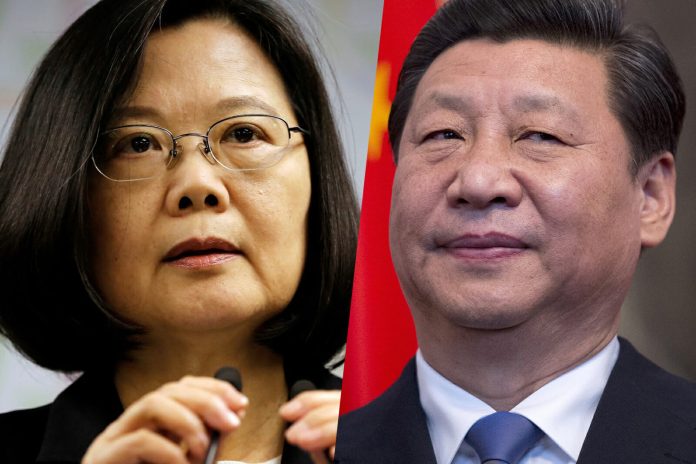China views Taiwan as part of its territory and vows to “unify” the democratically-governed island with the mainland, using force if necessary. Tensions between the two sides have been running high in recent years.
Tensions between China and Taiwan have been rising in recent years driven by differences over the island’s status.
Beijing claims sovereignty over the territory and has pledged to “unify” it with the mainland — by force if necessary.
Any military clash over Taiwan could also drag in the United States, given Washington’s special ties to Taipei.
Here’s a look at what the conflict is all about.
How did it start?
China and Taiwan have been separated since 1949, when the Chinese civil war ended with the victory of the Communists under the leadership of Mao Zedong. The defeated Nationalists, led by Mao’s archrival and chief of the Kuomintang (KMT) party Chiang Kai-shek, retreated to Taiwan.
Taiwan, which has been governed independently since then, is officially known as the Republic of China while the mainland is called the People’s Republic of China.
The island is separated from China by the Taiwan Strait. It has a democratically elected government and is home to around 23 million people.
For over seven decades, Beijing has continued to view Taiwan as a renegade province and vows to “unify” it with the Chinese mainland.
What is Taiwan’s international status?
Beijing’s stance is that there is only “one China” and that Taiwan is part of it.
China pressures countries worldwide to switch their allegiance to Beijing and cut diplomatic ties with Taiwan.
At present, only 14 countries maintain official diplomatic relations with Taiwan.
Taipei is also not a member in agencies of the United Nations, although it holds membership of organizations like the Asian Development Bank and the World Trade Organization.
China also puts pressure on companies worldwide to list Taiwan as a part of China.
Governments and firms that do not toe Beijing’s line on the issue risk backlash from the Chinese government.
In 2021, for instance, China cut off trade with EU member Lithuania for opening a Taiwanese representative office in its capital.
What’s the US’ relationship with Taiwan?
From almost three decades after the Communist government came to power in mainland China, the United States recognized the Republic of China as the government of all China.
But in 1979, Washington revoked its diplomatic ties and its mutual defense treaty with the ROC and established formal diplomatic relations with the PRC.
Despite the shift, Washington has maintained close unofficial ties with Taipei.
It continues to sell military gear to Taiwan for self-defense, even though Beijing has repeatedly warned not to. US Navy warships also regularly sail through the Taiwan Strait to project American military power in the region.
The US says its goal is to ensure peace and stability in the Taiwan Strait. To this end, it wants to maintain the status quo.
Under President Donald Trump, the US deepened military ties with Taiwan and increased arms deliveries, selling over $18 billion worth of weapons to the island.
President Joe Biden has said the US would come to Taiwan’s defense if China attacked.
Could China go to war over Taiwan?
Beijing hasn’t ruled out using force to pursue reunification of Taiwan with China.
In a major speech in January 2019, Chinese President Xi Jinping called for reunification and said that the status quo could not continue forever.
“We make no promise to renounce the use of force and reserve the option of taking all necessary means,” he said at the time.
Xi has also stressed that the reunification is essential for the realization of the “Chinese dream” of restoring the country’s great-power status in the world by 2049.
China is increasingly sending its fighters, bombers and surveillance aircraft near Taiwan, while also dispatching warships through the Taiwan Strait in a show of force.
The willingness to use force, coupled with China’s rapidly expanding military capabilities and deteriorating cross-strait relations, has raised fears that it could trigger a conflict.
What’s the current state of cross-strait relations?
Cross-strait tensions have escalated since the election of Taiwanese President Tsai Ing-wen in 2016.
READ ALSO: US urges China to condemn executions of democracy activists in Myanmar
Under Tsai, the independence movement in Taiwan has gained momentum.
The president’s Democratic Progressive Party favors independence for the island.
Tsai disputed the existence of the 1992 consensus, a political agreement reached by representatives of Taipei and Beijing on the nature of their relationship. Both parties agreed that there was only “one China,” although they had different views on what that meant.
Tsai and the DPP have also increased defense spending, with a record budget of nearly $17 billion (€16.7 billion) for 2022.
On Tuesday, Tsai boarded a naval warship for only the second time in her six years in office, where she lauded the military’s determination to defend the island while overseeing its largest annual naval and air exercises.
The drills, which simulate the repulsion of an invading force, are part of efforts to boost combat preparedness in the face of rising military pressure from China.
When asked about the drills, Chinese Foreign Ministry spokesman Zhao Lijian repeated China’s warnings about any military moves by Taiwan, Reuters reported.
“Taiwan’s attempt to confront China militarily is akin to a mantis trying to obstruct a chariot,” he said. “In the end, it is doomed to fail.”
Click Here to Read The Original Post













